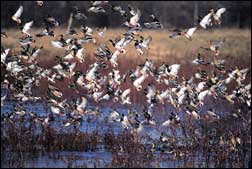Southern Ecosystems and Symbiotic Relationships
By: Amos S. Eno
Posted on:08/05/2010 Updated:08/06/2010Our new Mississippi State Conservation Center highlights the Magnolia state’s wildlife, forests, and agriculture.
This week we are rolling out our newest website: the Mississippi State Conservation Center. A lot of folks who are fans of our websites are stunned when they learn that PLN plus all seven of our satellite sites have been developed by only 4 people - and my role is as chief fundraiser and advocate - I don’t do the actual site development. So, I’d like to recognize and say thanks to my wonderful staff:
- Willard Dyche, Project Developer, who is the programming master mind largely responsible for the utility of these sites;
- Laura Dover, Director of Operations, who is the artist behind the beautifully clean graphics we employ; and
- Mark Mass, Project Researcher, who is on top of all the latest news to keep our Project Updates and News up-to-date.
Our development

of the Mississippi site began in 2009, with a grant from the Walton Family Foundation and a partnership with
Wildlife Mississippi. Predictably, my relationship with James Cummins, Wildlife Mississippi’s Executive Director, goes back 21 years to the first grant they received from the National Fish & Wildlife Foundation (NFWF) in 1990. The Delta Wildlife Foundation, as they were called then, was relatively small and unknown, but as James says, when we first met through NFWF “we hit it off and realized we had common interests.”
Common Interest Number One: Conservation PolicyJames, a Greenville native, tells me that he’s always had a love for wildlife and the land. However, he “never really wanted to count rabbits, but wanted to work toward making an impact.” That’s the reason both he and I ended up working with the U.S. Senate, James on agricultural and natural resource policy, myself on natural resource appropriations.
James conceptualized the
WHIP program back in 1996. His idea to make Farm Bill programs more flexible in promoting wildlife habitat was first implemented in 2002. In 2009 more than 800,000 acres were enrolled, but demand for the program was almost twice that.

Wildlife Mississippi collaborates in developing programs and tools with the private landowner in mind, such as the NRCS/NFWF
Migratory Bird Habitat Initiative to promote early floodup of wetlands, crop fields and retired catfish ponds outside of the spill area along the Gulf coast. The response from landowners has been huge, and these alternative habitats will help millions of migratory birds that have already begun descending upon the region to avoid the oil.
Common Interest Number Two: Mississippi ForestsMississippi’s forest habitats are prominently featured on our website, and James is working to use the NRCS
Healthy Forests Reserve Program to improve Mississippi forest management. The program works with private landowners to help recover threatened and endangered forest species by converting land back to longleaf pine or restoring bottomland hardwoods.
James says that one of the lessons Hurricane Katrina taught was the resilience displayed by Southern longleaf pine in the aftermath of the storm. Whereas many loblolly plantations were
left in shreds on the ground, longleaf largely remained standing.
As he points out, the longleaf pine ecosystem not only supports rare natives such as Gopher Tortoise, Red-cockaded Woodpecker, and Pitcher Plants, it will also “reduce our risk to hurricanes because longleaf are adapted to local conditions,” including the storms that are periodically spawned in the Gulf of Mexico.
Common Interest Number Three: Tara WildlifeMy own ties to Misssissippi are also personal. I’ve spent a lot of time in Mississippi over the years at the invitation of Maggie Bryant, who I first met in 1988. Maggie was my NFWF Board chair and is a close friend and supporter of
Resources First Foundation and the Mississippi site.
Maggie’s roots in Mississippi go way back, through her deceased husband’s family. Maggie recently told me that when she inherited the area now known as
Tara Wildlife she said to herself, “the property’s been in the family for 200 years, it probably ought to stay another 200 years. So how do I do that?”
In her typically modest fashion, Maggie began asking for advice, and eventually settled on the idea of putting a conservation easement on the land and starting her own hunt club, specializing in deer and turkey. “We all fox hunted, so I said we’ll do our own club, and a lot of experiments later, here we are still learning.” They are also one of the largest participants in the Migratory Bird Habitat Initiative to help birds migrating toward the Gulf.
Maggie says that her interest in conservation came from her father “who didn’t know he was a conservationist. He was a fox hunter, and he knew he had to maintain the habitat, since as most hunters know: no habitat means no hunting.”

That also applies to me, since my father began taking me along to learn the difference between a Sharp-shinned and a Cooper’s Hawk at the age of five. This brings me to probably the most important commonality in all our relationships at PLN. Like the longleaf and the gopher tortoise, we all rely on one another to create something greater than the sum of our parts. I’m lucky to be working with some rare individuals. To those of you in my “ecosystem,” I say thank you.
 Sign In
Sign In
 Sign In
Sign In
